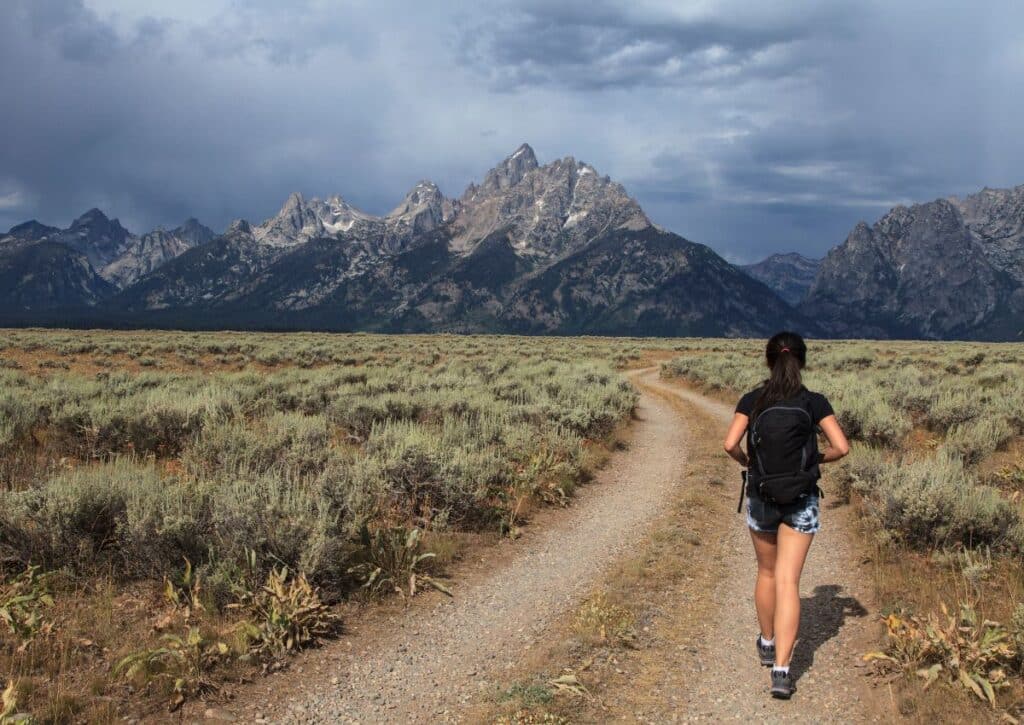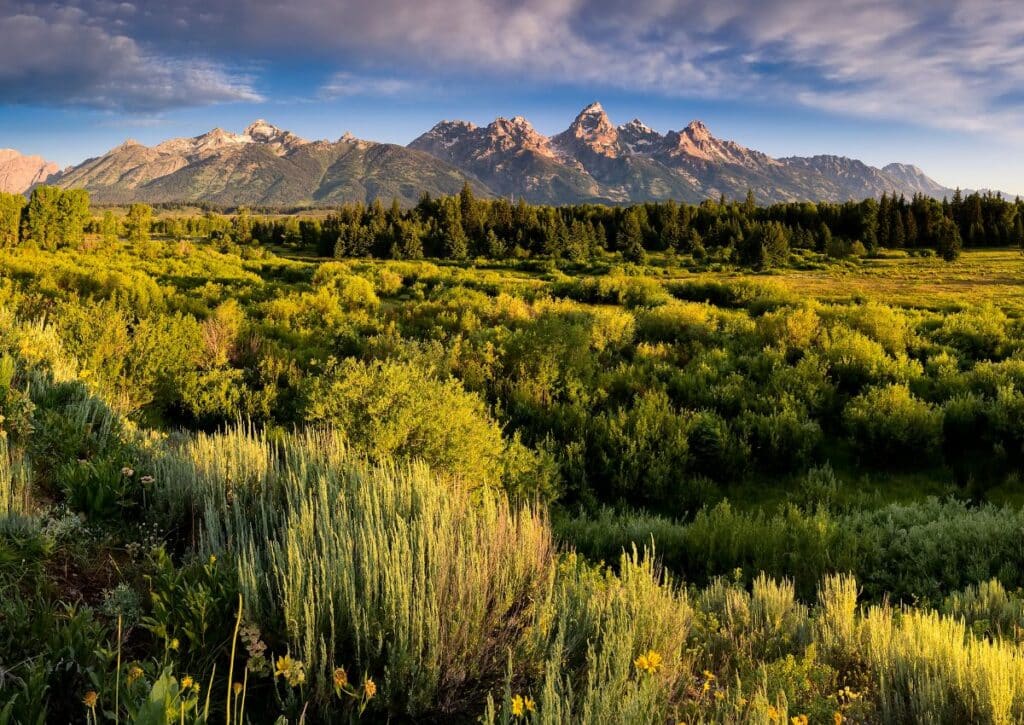Spot 25 Animals in Grand Teton National Park: A hiker's photo guide with trails for best views
Grand Teton National Park, spanning over 310,000 acres in northwestern Wyoming, is a premier destination for wildlife enthusiasts and hikers alike.
The park boasts more than 200 miles of trails, each offering a unique perspective of its rich biodiversity.
After 3 decades of hiking in the Grand Tetons we assure you wildlife sightings as you trek through diverse landscapes, from lush valleys to rugged mountain terrains. Sightings of moose, often found near water bodies, are common. The park is also home to large mammals like elk, bison, and both grizzly and black bears.
Bird watchers can anticipate spotting bald eagles, ospreys, and trumpeter swans among others.
This guide aims to provide insights and tips for those keen on experiencing the park’s wildlife during their hikes.
With careful planning and a keen eye, your hiking trip in Grand Teton can transform into an unforgettable wildlife adventure.
Moose
Moose, unmistakable with their towering frame and broad antlers, are a highlight for many visitors to Grand Teton National Park. Adapted to both woodland and aquatic environments, they often frequent the park’s wetlands, feeding on willows and submerging their heads to access aquatic plants.
The marshy areas along the Snake River are particularly popular with these herbivores, providing a rich diet and a serene backdrop for observers.
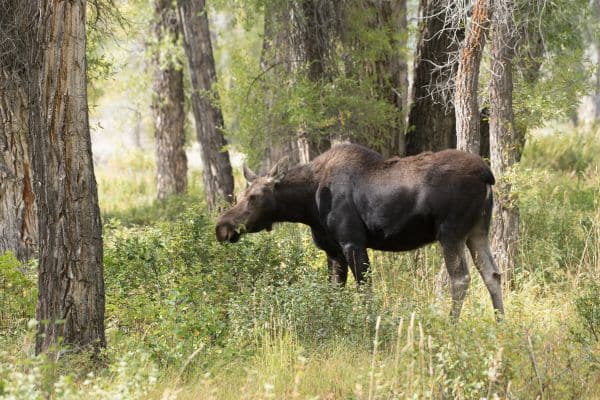
When it comes to hiking trails known for moose sightings, the Jenny Lake Trail is a top choice. This 7.5-mile trail offers panoramic views of Jenny Lake and meanders through dense woods and marshy terrains — environments moose thrive in.
Similarly, the String Lake Trail, which stretches approximately 3.8 miles, winds through rich moose habitats, with its combination of dense forest cover and accessible water sources.
An interesting note about moose in Grand Teton is their largely solitary behavior. While other large mammals in the park might be observed in groups, moose are frequently seen alone or occasionally accompanied by their offspring.
Visitors should exercise caution and respect their space, especially during calving season, as moose can be protective and unpredictable when approached.
Elk
Elk, characterized by their elegant antlers and graceful stance, are another focal point for wildlife enthusiasts in Grand Teton National Park. Part of the deer family, elk are larger than most deer and have a unique bugling call, especially pronounced during the mating season.
In Grand Teton, elk are drawn to the expansive meadows and grasslands, where they graze on a diet of grasses, plants, leaves, and bark.
The Willow Flats area, with its abundant greenery, is a preferred grazing site for these herbivores. Another spot within the park that frequently hosts elk is the area around Oxbow Bend, especially during the fall migration.
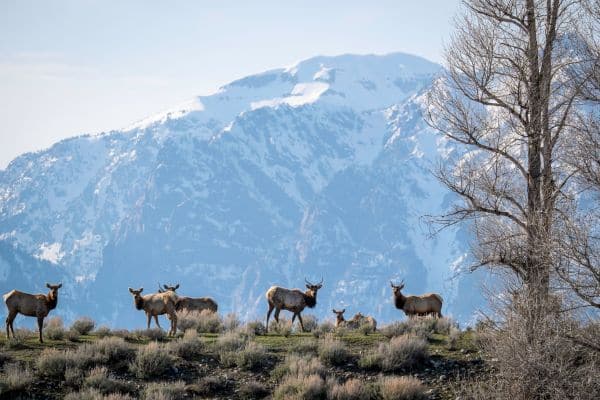
For those keen on observing elk during their hikes, the Teton Crest Trail is a promising route. Stretching for about 40 miles, though most visitors tackle shorter segments, this trail crosses varied terrains favored by the elk, from open meadows to forested areas.
Another route, the Cascade Canyon Trail, which covers around 9 miles, passes through the heart of elk habitats, increasing the chances of sightings.
Grand Teton’s elk population is notable for its migratory behavior. They move to higher altitudes in warmer months and descend to valleys during winter.
However, despite their size and often peaceful demeanor, elk can be territorial, especially during the rutting season. It’s essential for visitors to keep a safe distance and avoid any interference with these majestic creatures.
Coyote
Coyotes, often mistaken for wolves due to their similar appearance, hold a unique place in the ecosystem of Grand Teton National Park. These adaptable canids, with their pointed ears, slender muzzle, and notable bushy tail, are opportunistic feeders and can thrive in various environments.
Within Grand Teton, coyotes often inhabit the transitional zones between meadows and forests. These areas provide them with ample prey, including rodents, rabbits, and sometimes even larger mammals or birds.
The sagebrush-dominated landscapes, especially around the Sage Flat area, often echo with the hauntingly beautiful chorus of coyote howls, especially during dawn and dusk.
For hikers eager to catch a glimpse of these elusive creatures, the Death Canyon Trail, covering a span of around 8 miles, traverses through terrains that coyotes frequent.
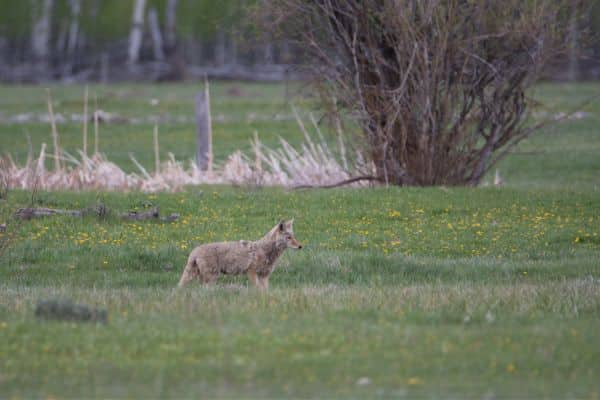
Another trail worth exploring is the Two Ocean Lake Trail, approximately 6.4 miles long, which offers diverse habitats and a good chance to spot a coyote, especially during the early morning or late evening when they are most active.
Coyotes, being extremely adaptable, have learned to coexist closer to human environments, and while they might appear docile or indifferent, it’s crucial to remember they are wild animals.
Encounters should be treated with caution, ensuring both your safety and the well-being of the animal.
American Black Bear
The American black bear, a symbol of North America’s vast wilderness, is a prominent resident of Grand Teton National Park. Smaller than its cousin, the grizzly bear, the black bear can be identified by its straight facial profile, tall ears, and lack of a shoulder hump. Despite its name, this bear’s fur can vary in color from black to brown or even cinnamon.
Within the park, black bears are primarily forest dwellers, preferring the dense wooded areas which offer both cover and a rich diet.
They forage for berries, nuts, and plants, but they’re also opportunistic feeders, consuming insects, fish, and even small mammals. The thick forests around Bradley and Taggart Lakes are known hotspots for black bear sightings.
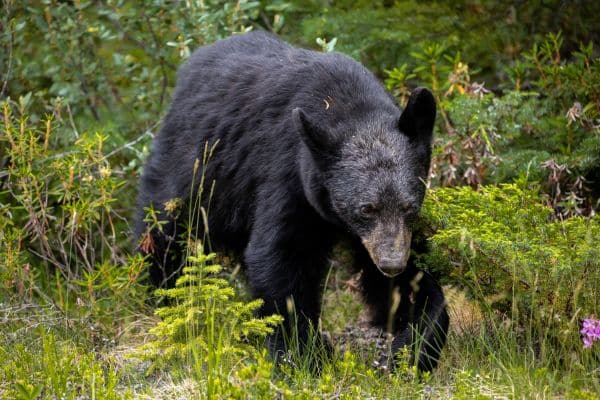
Hikers looking to observe these bears in their natural habitat might consider the Signal Mountain Trail, which is approximately 6.8 miles long. This trail, with its blend of dense woods and open spaces, provides an environment conducive to black bear activity.
Another promising trail is the Granite Canyon Trail, stretching around 8.5 miles, known for occasional black bear sightings amidst its scenic backdrop.
It’s of utmost importance to remember that while black bears might appear less intimidating than grizzlies, they are still wild creatures.
Visitors should always maintain a safe distance, store food securely, and carry bear spray as a precautionary measure. Encountering a bear is a thrilling experience, but it’s crucial to prioritize safety above all.
Wolves
The return of wolves to Grand Teton National Park has been one of nature’s most captivating comebacks. Wolves, with their keen eyes, sharp senses, and iconic howls that echo through the valleys, are an integral part of the park’s ecosystem.
These apex predators play a vital role in maintaining the health and balance of various wildlife populations.
In the vast expanse of Grand Teton, wolves predominantly roam the remote and rugged terrains. They often establish territories near water sources and open meadows, which offer a plethora of prey, including elk, deer, and smaller mammals. The Pacific Creek area, with its mix of open spaces and dense woods, has been known for wolf activity.
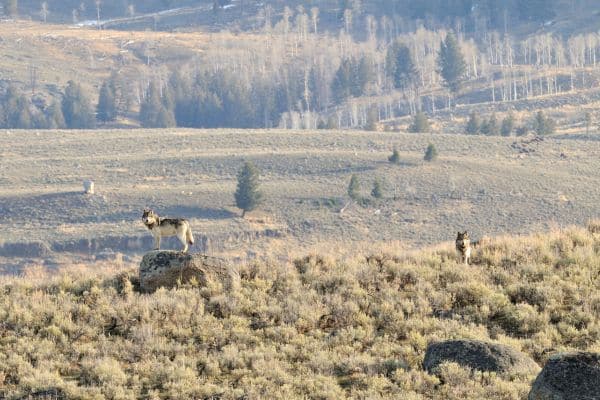
For those adventurous hikers hoping to witness the elusive behavior of wolves, the Moose-Wilson Road region offers potential sightings, especially during the early morning hours when wolves are most active.
The Garnet Canyon Trail, covering roughly 8.4 miles, traverses through territories that wolves occasionally frequent. It’s a hike not just known for its scenic beauty but also its connection to the wilder side of Grand Teton.
However, it’s essential to approach the idea of wolf-spotting with respect and caution. Wolves are wary of humans and usually keep their distance.
While the odds of a close encounter are low, it’s crucial to remain vigilant and ensure that these magnificent creatures are observed without disruption or harm.
Great Blue Heron
The Great Blue Heron, with its statuesque stance and regal bearing, is a striking sight against the natural canvas of Grand Teton National Park. As one of the largest herons in North America, it can be identified by its long, sinuous neck, sharp bill, and slate-gray plumage, which is gracefully offset by shades of blue and purple.
In the park, these herons are most commonly found near freshwater habitats. They prefer the calm and serene water bodies where they can wade and hunt. Their diet primarily consists of fish, but they’re known to consume a wide variety of prey, including amphibians, crustaceans, and even small mammals.
The edges of Swan Lake and Hermitage Point, with their shallow waters and abundant food sources, are favorite haunts for these majestic birds.
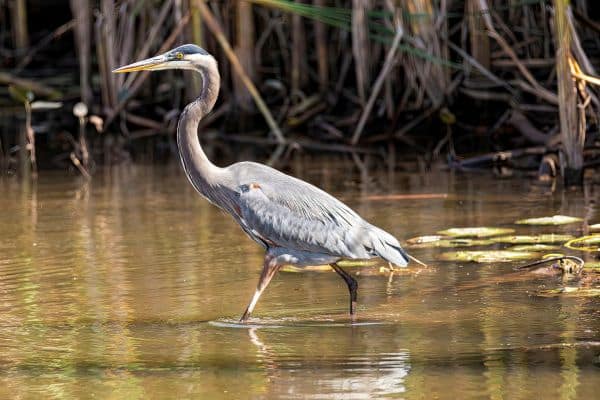
For birdwatchers and hikers keen on observing the Great Blue Heron, the Christian Pond Loop, a trail of about 3.3 miles, offers promising opportunities. Winding around a tranquil pond and passing through diverse habitats, this trail provides ample chances to spot a heron in action, often seen standing motionless before making a lightning-fast strike to catch prey.
While the Great Blue Heron is often preoccupied with its hunting endeavors, it’s important for visitors to observe from a distance. Disturbances can cause these birds to abandon their feeding grounds, so it’s essential to approach their habitats with care and consideration.
Trumpeter Swans
Trumpeter Swans, with their pristine white plumage and imposing presence, are a testament to nature’s grandeur within Grand Teton National Park.
As the largest native waterfowl species in North America, they are characterized by their long necks, black bills, and deep, resonant calls that can be heard echoing across the park’s tranquil water bodies.
The park’s myriad ponds, lakes, and rivers provide the perfect habitat for these swans. They are particularly drawn to areas with abundant aquatic vegetation, which forms a significant portion of their diet, though they also consume small fish and invertebrates.
Oxbow Bend on the Snake River stands out as a favored location for these birds, offering a mix of shallow waters and abundant food.
For those aiming to spot these magnificent swans, the Colter Bay Lakeshore Trail, stretching approximately 2 miles, is a prime location.
Nestled alongside Jackson Lake and weaving through a mix of habitats, this trail offers panoramic views where the white of the swans stands in stark contrast against the park’s blues and greens.
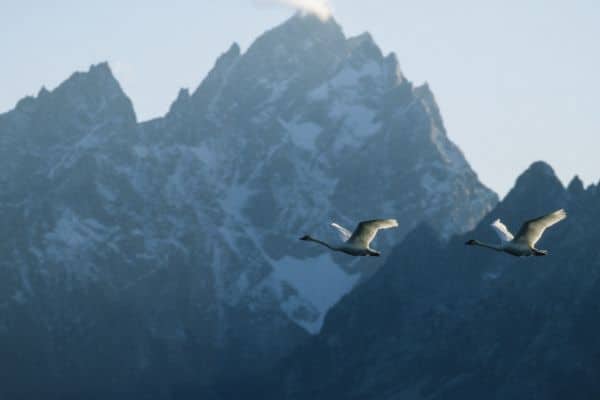
Trumpeter Swans are a conservation success story, having rebounded from the brink of extinction in the early 20th century.
When observing them, it’s crucial to minimize disturbances, ensuring that Grand Teton remains a safe haven for these majestic birds. Their nesting sites, in particular, should be approached with caution to protect the next generation of swans.
Mule Deer
Mule deer, named for their large, mule-like ears, are a common and delightful sight in Grand Teton National Park. With a distinctive white rump patch and black-tipped tail, they are easily distinguishable from other deer species.
These herbivores are well-adapted to a variety of habitats, which is evident in their widespread presence across different terrains of the park.
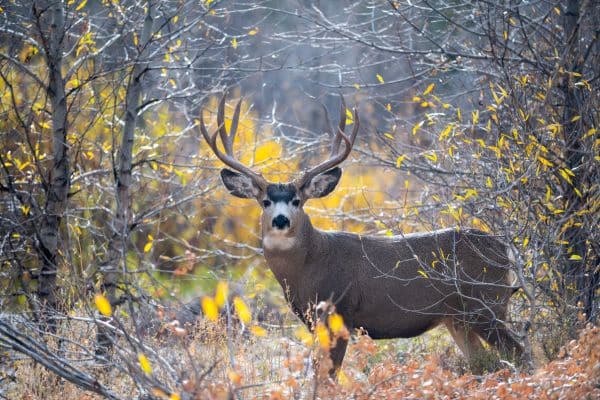
In Grand Teton, mule deer primarily roam the sagebrush valleys and lower forested areas, where they graze on a mix of shrubs, grasses, and forbs.
During the colder months, they migrate to lower elevations in search of food, making the areas around Antelope Flats and Gros Ventre Road popular spots for winter sightings.
For hikers looking to observe mule deer in their natural environment, the Lupine Meadows Trail, which spans about 4.8 miles, is a recommended route.
The trail’s combination of meadows, woods, and gentle elevations is conducive to mule deer activity, especially during dawn and dusk when they are most active.
While mule deer are generally more approachable compared to larger mammals in the park, it’s essential to view them from a respectful distance.
Especially during the spring fawning season, does can be protective of their young. As always, it’s vital to ensure that human presence doesn’t alter their natural behaviors or stress these graceful creatures.
Grizzly Bear
Grizzly bears, one of the most iconic and formidable residents of Grand Teton National Park, command both respect and awe.
With their distinctive hump on their shoulders, a result of strong muscles used for digging, and longer, curved claws compared to their black bear counterparts, they are a symbol of the wild, untamed spirit of North America’s wilderness.
In Grand Teton, these bears primarily occupy the vast, remote stretches, although they can be found in a variety of habitats, from dense forests to alpine meadows. They are omnivores with a diverse diet, including berries, fish, smaller mammals, and even larger prey like elk.
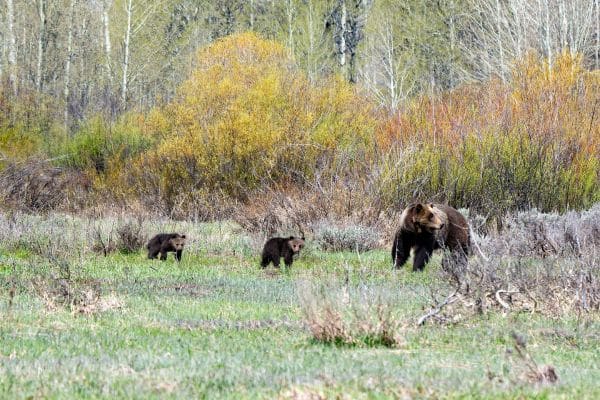
Areas around Pilgrim Creek and the northern parts of the park, such as Sheepeater Canyon, are often frequented by grizzlies.
For those keen on spotting a grizzly, the Teton Canyon Trail, which extends about 5 miles into the park’s rugged interior, is an advisable route. The trail offers a mix of forested and open terrains, habitats that grizzlies frequent, especially during early morning or late evening.
The majestic presence of grizzlies in the park comes with a strong reminder of the importance of safety. These are wild, powerful animals, and encounters should always be approached with caution.
Carrying bear spray, making noise while hiking, and maintaining a safe distance are essential precautions. Furthermore, ensuring that food is stored securely can prevent unwanted bear interactions, safeguarding both the animal and visitors.
Western Tanager
The Western Tanager, with its vibrant hues and melodic song, is one of the many avian jewels of Grand Teton National Park.
Males are particularly striking, boasting a brilliant yellow body contrasted with a radiant red head and black wings, while females don a more subdued yellow-green plumage.
In the park, Western Tanagers are typically found in coniferous forests, especially during breeding season, where they nest high in the trees.
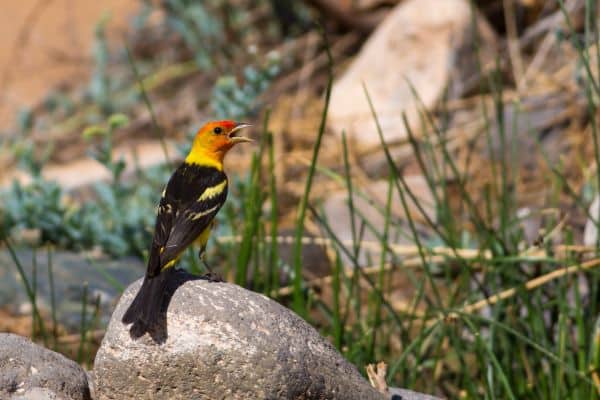
They feed predominantly on insects but will also consume fruits, making them a frequent visitor to berry-laden shrubs during late summer.
The dense woodlands around Phelps Lake and the higher elevations near Cascade Canyon are prime habitats where these birds are often spotted.
For bird enthusiasts hoping to catch a glimpse of the Western Tanager, the Jenny Lake Loop, covering a distance of around 7.5 miles, offers promising opportunities.
The trail, with its rich blend of coniferous trees and open meadows, provides the diverse habitat these birds favor.
While their bright colors make them somewhat easier to spot than other bird species, patience is key. Early mornings, when the park’s avian residents are most active, increase the chances of sightings.
As with all wildlife, it’s crucial to observe Western Tanagers without disturbing them, ensuring they continue to thrive in the park’s pristine environment.
Bighorn Sheep
Bighorn Sheep, celebrated for their impressive curled horns and agile mountain-climbing abilities, are an emblematic species of Grand Teton National Park.
The males, or rams, possess large, spiral horns that can weigh up to 30 pounds, while the females, or ewes, have shorter, more slender horns.
In Grand Teton, these sheep are typically found in the park’s alpine regions, where steep, rugged terrains offer both the grassy meals they favor and protection from predators.
They excel in these high-altitude habitats, often seen navigating the rocky cliffs with surprising ease. The slopes and ledges around Mount Moran and Cascade Canyon are known areas where these sheep congregate.
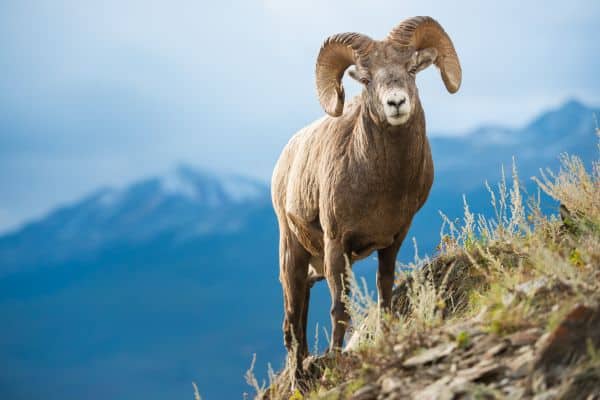
For adventurers eager to witness the nimble maneuvers of Bighorn Sheep, the Amphitheater Lake Trail, spanning about 10 miles round-trip, is a potential choice. This trail, which ascends into the heart of the Teton Range, traverses the elevations and habitats favored by these sheep, particularly during the summer months.
Observing Bighorn Sheep in their natural, mountainous environment is an unforgettable experience, but it’s essential to view them responsibly.
Approaching too closely can stress the animals and alter their behaviors. It’s always best to use binoculars or a telephoto lens to appreciate their majesty without intrusion, ensuring that these iconic creatures of the Tetons continue to thrive.
Clark’s Nutcracker
The Clark’s Nutcracker, a bird both industrious and intelligent, is an intriguing species that calls Grand Teton National Park home.
Recognizable by its sharp black, white, and gray plumage, and its long, pointed bill, this member of the corvid family exhibits behavior that’s fascinating to both ornithologists and casual observers.
In the park, the Clark’s Nutcracker primarily frequents coniferous forests, especially areas with a high concentration of whitebark pines.
These pines are essential to their diet, as they feed on the tree’s seeds. The regions around Jenny Lake Overlook and the higher elevations of Paintbrush Canyon are spots where these birds are commonly spotted.
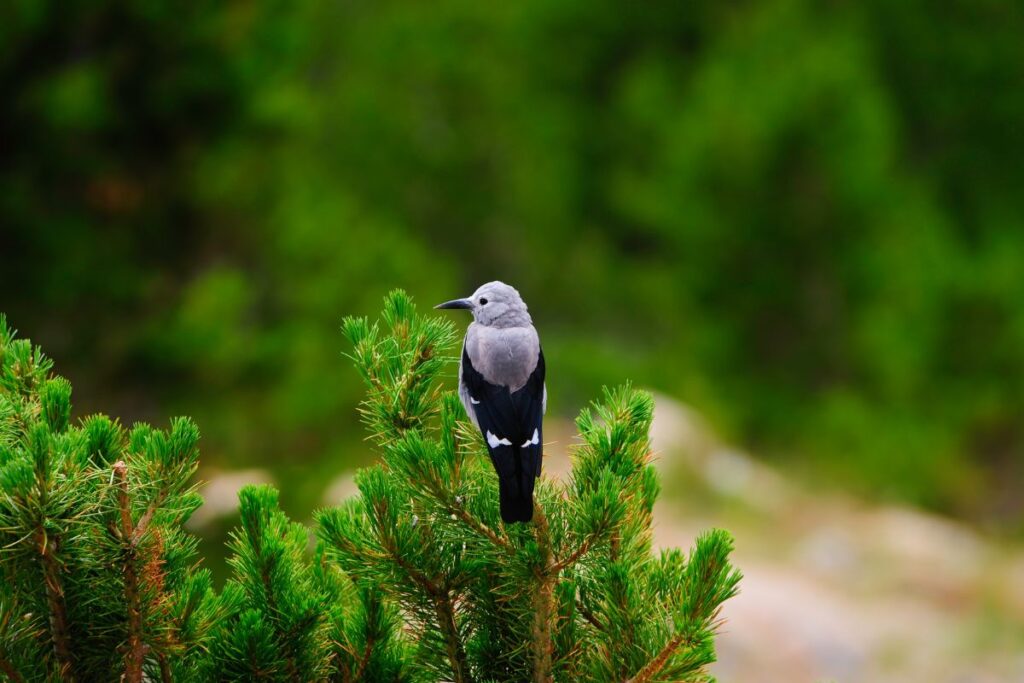
For birdwatchers looking to observe the unique seed-storing behavior of the Clark’s Nutcracker, the Cascade Canyon Trail, a journey that covers about 9.7 miles round-trip, is a prime choice. As the trail winds through dense forests and alpine environments, it offers ample opportunities to witness these birds in action.
One of the most remarkable traits of the Clark’s Nutcracker is its ability to store seeds in various locations and remember them, retrieving these caches even months later.
This behavior plays a crucial ecological role, as the forgotten seeds often germinate, contributing to forest regeneration. While watching these birds, it’s best to do so quietly, allowing their natural behaviors to unfold undisturbed.
Pronghorn
Pronghorns, often mistakenly called antelope, are one of the most distinctive and swift mammals gracing the landscapes of Grand Teton National Park. With their sleek tan bodies, striking white markings, and uniquely branched horns, pronghorns stand out against the backdrop of the Tetons.
Within Grand Teton, pronghorns predominantly favor the open plains and grassy valleys, areas that allow them to capitalize on their incredible speed, which can reach up to 55 miles per hour.
These areas not only provide them with the vegetation they graze on but also a clear line of sight against potential threats. The flat expanses around Sagebrush Flats and the meadows near Gros Ventre River are known locations where pronghorns gather and graze.
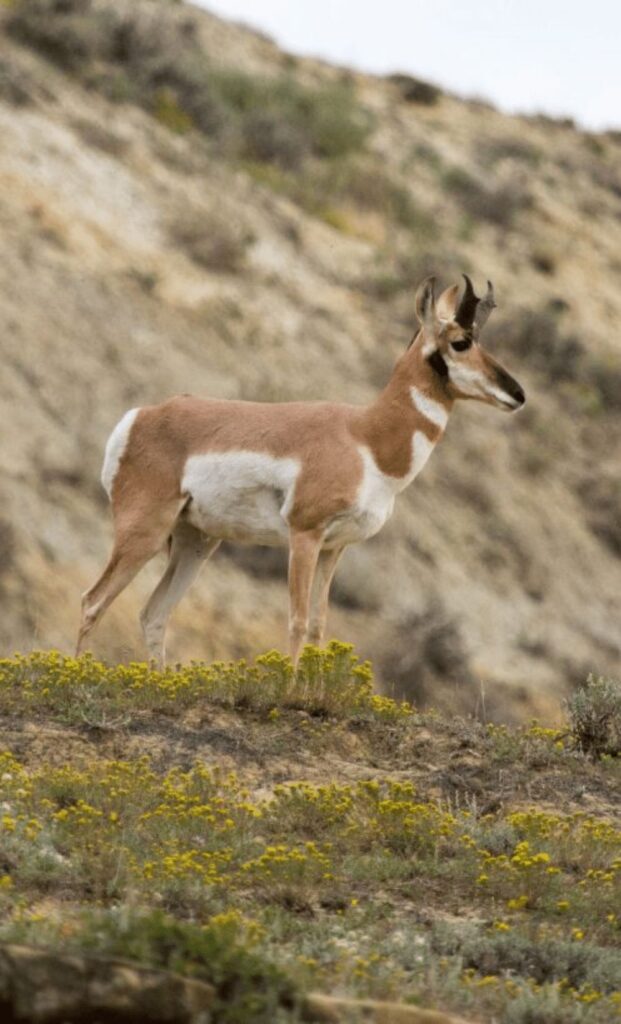
For visitors keen to observe these fast creatures, the Sage Creek Loop, spanning around 3.1 miles, offers a good opportunity.
This trail, with its stretches of open fields and panoramic vistas, runs through pronghorn-frequented areas, especially during early morning or late afternoon hours.
One unique aspect of pronghorns is their incredible vision, which is believed to be among the best of any terrestrial animal.
This, combined with their unmatched speed, has allowed them to thrive in open terrains. When observing pronghorns, it’s essential to do so from a distance, ensuring minimal disturbance to their natural routines and behaviors.
Bison
Bison, often referred to as buffalo, are the living testament to North America’s rich natural heritage and are among the most iconic residents of Grand Teton National Park.
With their massive frame, shaggy mane, and sharp horns, bison symbolize the raw power and majesty of the American West.
Within the park, bison primarily graze in the expansive grassy valleys and open plains, where they feed on grasses, herbs, and other vegetation.
The vast meadows around Antelope Flats and Kelly Warm Springs are common grounds where these magnificent animals can be seen, often in herds, moving leisurely or rolling in the dust during wallowing behavior.
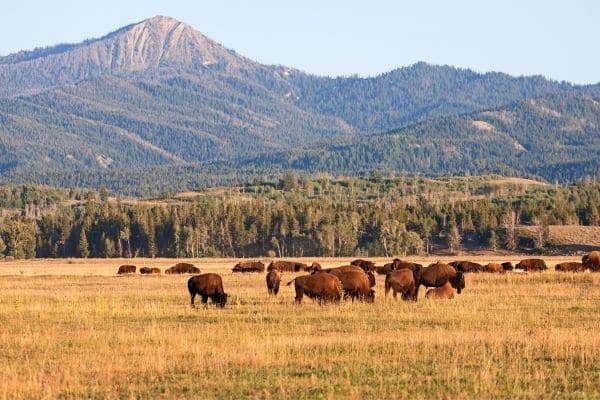
For visitors aiming to view bison in their natural habitat, the Elk Ranch Flats Turnout, with its expansive open fields, provides a front-row seat to observe these herbivores, especially during the early morning or late afternoon when they are most active.
Though they might appear slow and docile due to their size, bison are incredibly agile and can be unpredictable. They are known to charge if they feel threatened or provoked.
As such, it’s imperative for visitors to maintain a safe distance, a minimum of 25 yards, and avoid any actions that might disturb or stress these powerful creatures. Proper etiquette ensures that one can marvel at the bison’s grandeur without endangering oneself or the animal.
Bald Eagle
The Bald Eagle, a symbol of freedom and majesty, graces the skies of Grand Teton National Park with its commanding presence.
Recognized by its stark white head and tail contrasting with a dark brown body, and a wingspan that can exceed seven feet, the bald eagle is a sight to behold and an emblem of American wildlife.
In Grand Teton, these raptors favor areas close to large bodies of water, where they can hunt for their primary prey: fish. The shores and skies around Jackson Lake and the Snake River corridor are particularly favored by these birds, offering abundant food sources and tall trees for perching and nesting.
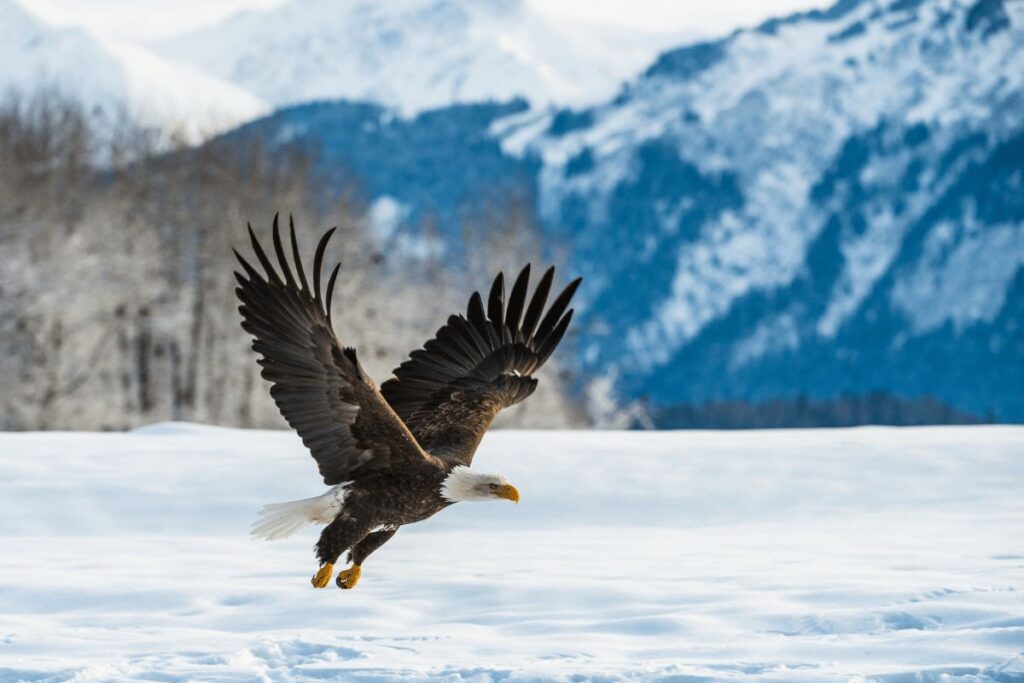
For visitors with a keen interest in spotting a Bald Eagle, the Oxbow Bend Turnout, with its sweeping views of still waters and surrounding forests, is an ideal location.
The Moose-Wilson Road, which winds along a stretch of around 8 miles, provides a varied habitat that bald eagles frequent, especially when the river waters thaw and fish become more accessible.
While the Bald Eagle was once on the brink of extinction in the lower 48 states, conservation efforts have led to a remarkable recovery. Observing one in the wild, especially as it dives to snatch a fish from the water, is a testament to nature’s resilience.
As always, when watching these majestic birds, it’s vital to maintain a respectful distance, ensuring their continued prosperity in their natural habitats.
Mountain Lion
Mountain lions, also known as cougars or pumas, are among the most elusive and awe-inspiring predators of Grand Teton National Park. With their sleek, tawny coats and piercing eyes, these big cats move with a stealth and grace that belies their power.
In Grand Teton, mountain lions tend to inhabit the more remote and rugged areas of the park. These solitary animals prefer dense forests, canyons, and rocky terrains, which provide cover for stalking prey and raising their young.
Their diet primarily consists of deer, but they’re also known to prey on smaller mammals like rabbits and rodents.
The dense woodlands around Death Canyon and the rocky terrains near Garnet Canyon are areas where these elusive cats have been known to roam.
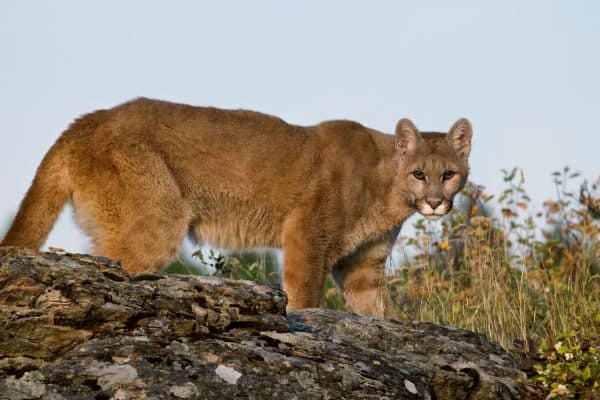
For those intrepid hikers hoping to catch a glimpse of a mountain lion, the Teton Crest Trail, which delves deep into the park’s wilderness, offers a chance. While sightings are rare due to the lion’s secretive nature, the trail traverses through prime mountain lion habitat, especially its more remote sections.
It’s crucial to remember that mountain lions, while magnificent, are wild predators. Encounters, though infrequent, should be approached with caution.
Making noise while hiking and avoiding dawn or dusk excursions can reduce the chances of an unexpected meeting. And in the event of an encounter, it’s essential to stand tall, maintain eye contact, and never run. Safety and respect for these majestic creatures go hand in hand in ensuring a harmonious experience within the park.
Peregrine Falcon
The Peregrine Falcon, renowned for its unparalleled speed and aerial agility, is a dazzling avian presence in Grand Teton National Park.
Recognizable by its dark blue-gray back, barred underside, and distinctive black “moustache,” this raptor is famed for its mid-air hunting dives, known as stoops, which can reach speeds of over 200 miles per hour.
In Grand Teton, these falcons often favor cliff faces and high vantage points, which provide them with the elevation they need for their breathtaking dives and a suitable environment for nesting.
Areas like Cascade Canyon and the cliffs surrounding Jenny Lake are among the falcon’s chosen territories, where they nest on ledges and scan the surroundings for prey, typically other birds caught in mid-flight.
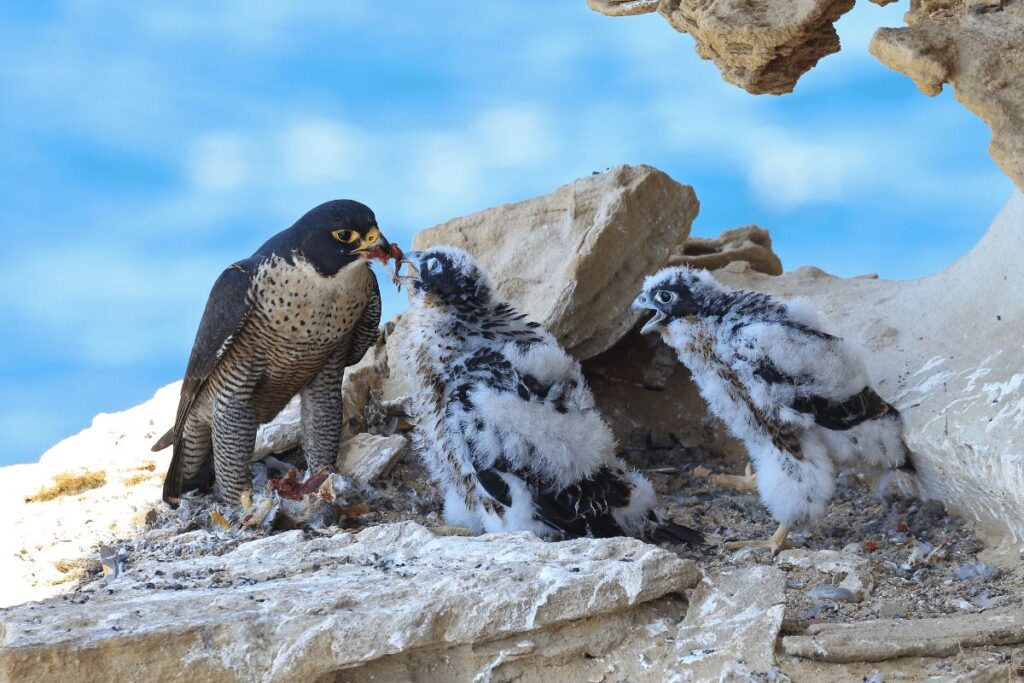
For birdwatchers and enthusiasts hoping to observe the Peregrine Falcon in action, the Hidden Falls Trail, spanning around 5 miles round-trip, is a prime location.
As the trail winds through terrains that include tall cliffs and open skies, it provides opportunities to witness the falcon’s impressive hunting maneuvers or spot them perched high, surveying their domain.
While Peregrine Falcon populations once faced significant declines due to pesticides like DDT, conservation efforts have bolstered their numbers in recent decades.
When observing these raptors, it’s essential to avoid any disturbances, especially during their nesting season. This ensures that future generations can continue to marvel at the unparalleled speed and prowess of the Peregrine Falcon in Grand Teton.
Osprey
The Osprey, often referred to as the “fish hawk,” is a masterful fisher and a regular sight above the waterways of Grand Teton National Park. Distinctive with its white underbelly, dark brown upperparts, and a characteristic black eye stripe, this raptor is specialized for a life centered around aquatic habitats.
With talons that can grip slippery fish and eyes that can spot underwater prey from significant heights, the osprey is a marvel of avian adaptation.
In Grand Teton, ospreys are predominantly found near freshwater lakes, rivers, and reservoirs, where fish are abundant. The areas around Jackson Lake and the Snake River are particularly frequented by these birds.
These water bodies provide them with a consistent food source and suitable sites to erect their large, often conspicuous nests atop dead trees, rocky outcrops, or even man-made structures.
For visitors looking to witness the osprey’s fishing prowess, the Lakeshore Trail around Colter Bay, which extends for about 2 miles, is a prime location.
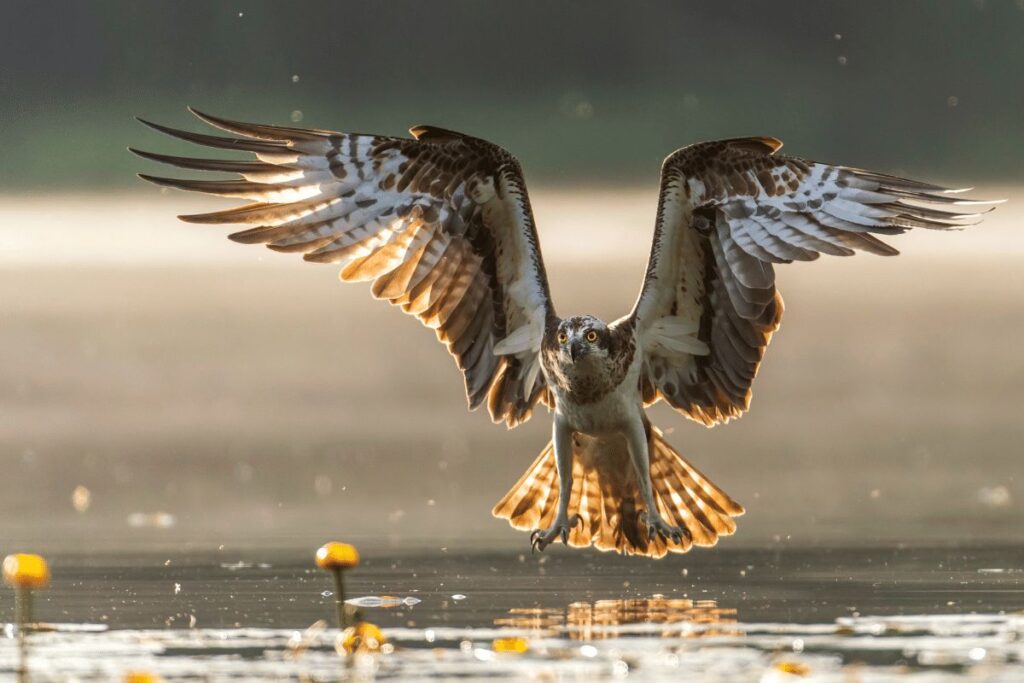
This trail offers panoramic views of the lake, where ospreys are often seen hovering before diving talon-first into the water, emerging with a catch.
Conservation measures have ensured that ospreys continue to thrive in many parts of North America, including Grand Teton.
Observers are reminded to watch these magnificent birds from a respectful distance, especially near nesting sites, ensuring that the osprey’s natural behaviors remain undisturbed and that the beauty of their fishing acrobatics can be appreciated by all.
North American River Otter
The North American River Otter, with its playful demeanor and agile aquatic abilities, brings a sense of liveliness to the waters of Grand Teton National Park.
Characterized by its streamlined body, sharp whiskered face, and thick waterproof fur, this mammal is expertly adapted for a semi-aquatic lifestyle.
In Grand Teton, river otters frequent freshwater habitats, particularly in lakes, rivers, and ponds where fish, their primary diet, are abundant.
Two Ocean Lake and the marshy inlets of the Snake River serve as ideal environments for these otters, providing them with ample food and the semi-secluded banks they prefer for their dens.
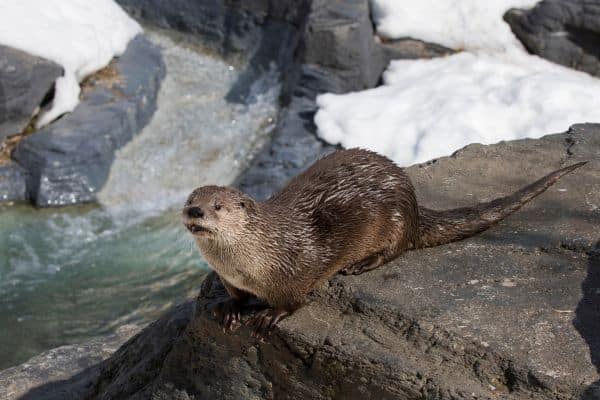
For park visitors eager to catch a glimpse of otter antics, the Emma Matilda Lake Trail, which circles around a serene 11-mile loop, is an excellent choice.
Along this trail, the quiet observer might be treated to sights of otters sliding down muddy banks, diving for fish, or simply frolicking in the water.
While river otters are known for their playful nature, it’s essential to understand they are still wild animals. Observers should always watch from a distance, resisting the urge to approach or disturb them.
This ensures safety for both the observer and the otter and allows the natural behaviors of these delightful creatures to unfold in their pristine habitat.
Mountain Goat
With their stark white coats and impressive climbing prowess, mountain goats are among the alpine icons of Grand Teton National Park. Possessing sturdy, cloven hooves and a keen sense of balance, these animals are uniquely adapted to navigate the steep, rugged terrains of the Tetons.
In Grand Teton, mountain goats predominantly reside in the park’s higher elevations, often seen scaling near-vertical cliffs and traversing narrow ledges. These alpine areas provide them with the grasses, herbs, mosses, and lichen that comprise their diet.
The rocky crags and outcroppings near Teepe’s Pillar and the high-altitude meadows around Disappointment Peak are frequented by these sure-footed creatures.
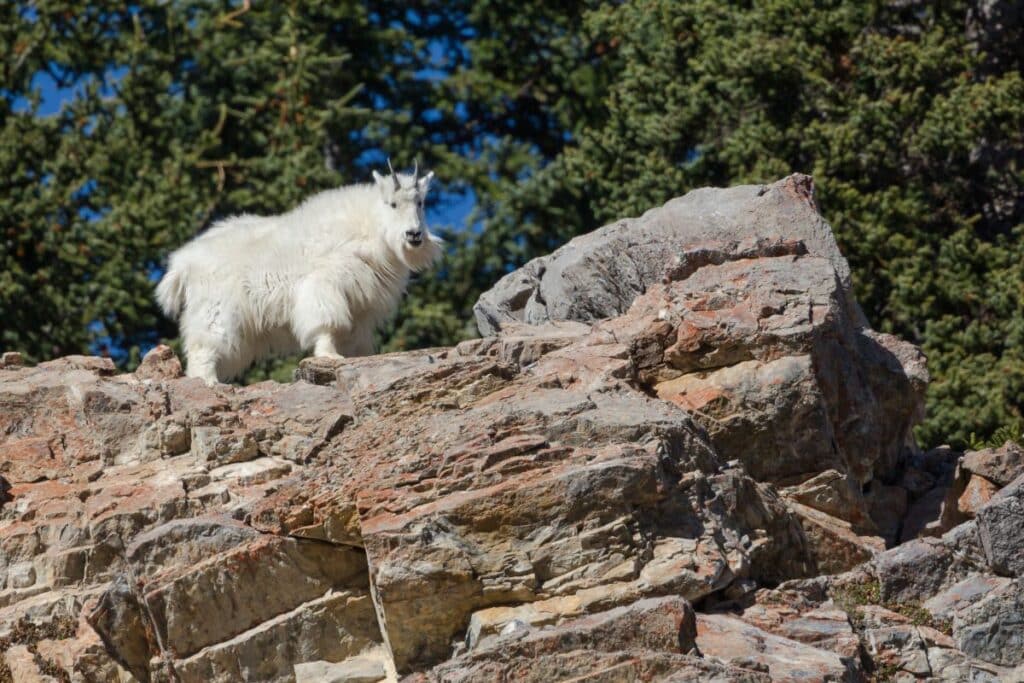
For those hoping to observe mountain goats in their lofty domains, the Teton High Route, though a challenging trek, offers some of the best opportunities.
This route ventures deep into the park’s alpine heart, where mountain goats can be seen gracefully navigating the rocky terrains, often with their young in tow.
It’s vital to approach sightings with caution and respect. While mountain goats might appear docile, they are wild creatures, and close encounters, especially during the birthing season or rut, can lead to unpredictable behaviors.
Observers are advised to use binoculars or a camera with a zoom lens, ensuring a safe and non-intrusive distance while appreciating the beauty and agility of these alpine specialists.
Beavers
Beavers, nature’s skilled engineers, play a pivotal role in shaping the ecosystems of Grand Teton National Park. Recognized by their stout bodies, paddle-shaped tails, and sharp, chisel-like teeth, these rodents are renowned for their dam-building capabilities, which in turn create vital habitats for various other species.
In Grand Teton, beavers are drawn to slow-moving streams, ponds, and rivers where they can access the trees and shrubs they both consume and use for construction.
The waterways around Cottonwood Creek and the ponds near Schwabacher’s Landing are locations where the handiwork of beavers—dams, lodges, and felled trees—can often be observed.
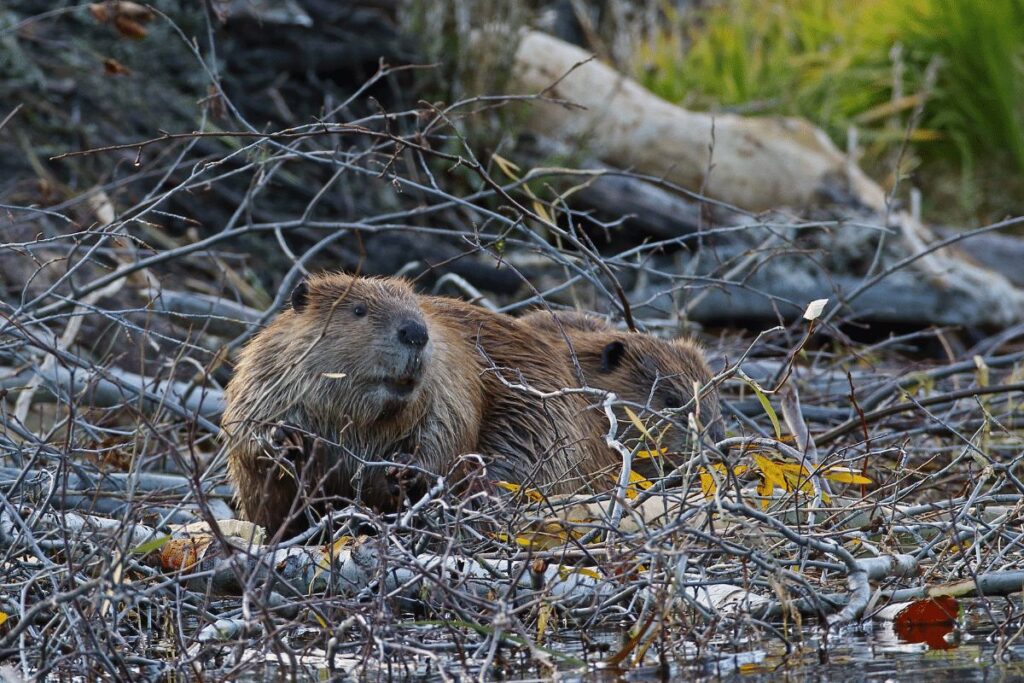
For visitors keen on spotting these industrious creatures, the Beaver Creek Trail, spanning roughly 5 miles, is aptly named and offers a high likelihood of sightings.
As the trail meanders alongside creeks and wetlands, there’s potential to see beavers busily working during the twilight hours or early morning, when they are most active.
While the dams and lodges of beavers might seem like simple structures, they are crucial in creating wetland habitats, controlling erosion, and enhancing biodiversity.
When observing beavers and their architectural marvels, it’s important to do so from a distance to avoid disturbing their activities. This ensures that they continue to thrive and shape the waterways of Grand Teton for years to come.
Red Fox
The Red Fox, with its fiery coat and bushy tail tipped with white, adds a splash of color and cunning to the landscapes of Grand Teton National Park. Known for their adaptability and intelligence, red foxes are versatile predators that can thrive in a variety of habitats.
Within Grand Teton, red foxes can be found across various terrains, from the open meadows to dense forests. They are opportunistic feeders, with a diet that includes rodents, birds, fruits, and insects.
The grasslands around Kelly Loop and the woodlands near Moose Junction are areas where these elusive creatures can occasionally be spotted, especially during the twilight hours.
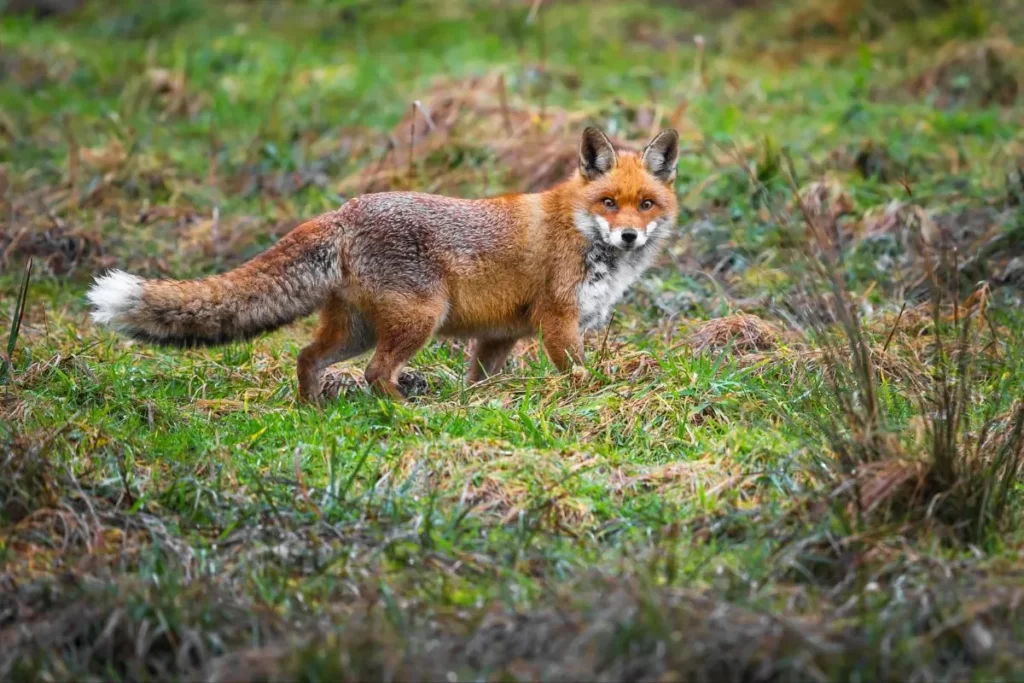
For those hoping to see the red fox in its natural setting, the Mormon Row Historic District trail, covering a distance of about 1.5 miles, is a promising location. This trail, with its mix of open fields and wooded patches, traverses through prime fox territory, where they might be seen hunting or simply trotting along with a keen sense of alertness.
Though they are often portrayed as sly in folklore, red foxes are wild animals that should be observed with caution and from a distance.
Their behaviors, from hunting to caring for their young, are a testament to their adaptability and resilience in the varied environments of Grand Teton. As with all wildlife, it’s essential to view them without interference, ensuring they continue their natural routines in the park’s vast wilderness.
Yellow-bellied Marmot
The Yellow-bellied Marmot, with its chunky build, curious eyes, and distinctive yellowish underbelly, brings a touch of whimsy to the rocky landscapes of Grand Teton National Park.
Often referred to as the “rock chuck,” this member of the squirrel family is well-suited to life in the park’s alpine regions.
Within Grand Teton, marmots predominantly inhabit rocky terrains and talus slopes, which provide them with protection from predators and ample sunning spots. They are herbivores, feasting on a variety of grasses, flowers, and even insects.
The boulder fields near Inspiration Point and the rocky outcrops of Cascade Canyon are typical environments where the playful antics of these marmots can be observed.
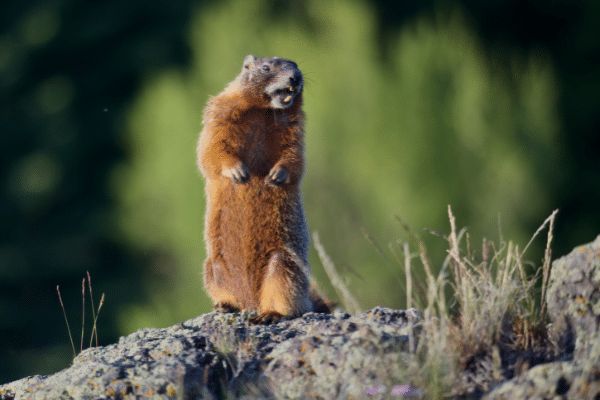
For visitors wanting a glimpse of these sun-loving creatures, the Hidden Falls Trail, a 5-mile trek that offers diverse terrain, is an excellent option.
As hikers navigate the trail’s boulder-strewn sections, the sight of marmots sunning themselves or emitting their characteristic whistles to warn of potential dangers is common.
Despite their often relaxed demeanor, Yellow-bellied Marmots are wild animals that have adapted beautifully to the alpine challenges of Grand Teton.
Observers are encouraged to enjoy their playful behaviors from a respectful distance, ensuring that the marmots remain undisturbed in their high-altitude homes.
Mountain Bluebird
The Mountain Bluebird, with its ethereal blue hue and graceful flight, is a visual delight against the vast landscapes of Grand Teton National Park. As a member of the thrush family, its radiant plumage, especially in males, is an enchanting sight, offering a vivid contrast to the park’s greens and browns.
Within Grand Teton, these bluebirds prefer open meadows and areas of sparse vegetation, which provide them with ample perching sites and opportunities to hunt for insects on the wing.
The expansive grasslands around Spread Creek and the open terrains near Mormon Row are areas where these avian beauties can often be spotted, fluttering close to the ground or perched on low shrubs.
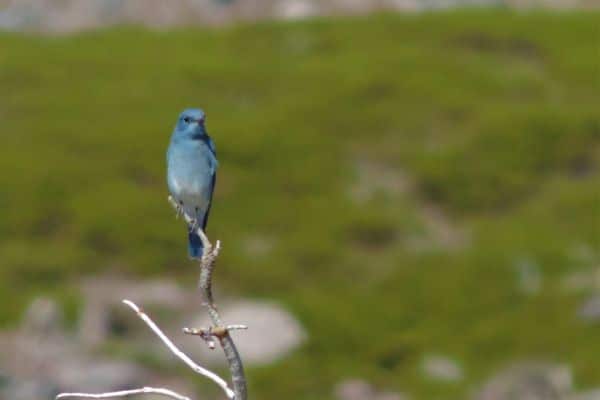
For bird enthusiasts hoping to observe the Mountain Bluebird in its natural habitat, the Sagebrush Flats Area, with its vast open spaces and occasional clusters of trees, provides an ideal setting.
Here, amidst the undulating plains, the bluebirds can be seen darting through the air, capturing insects with remarkable agility.
Their striking color and elegant demeanor make Mountain Bluebirds a sought-after sight in Grand Teton. While enjoying their aerial acrobatics, it’s vital to observe them without causing any disturbance.
As with all wildlife, a respectful distance ensures that these birds can continue their natural behaviors, adding their vibrant touch to the park’s rich tapestry of life.
Sandhill Crane
The Sandhill Crane, with its stately posture, long legs, and distinctive red crown, is an emblematic presence in the wetlands and grasslands of Grand Teton National Park.
Their trumpeting calls, both haunting and melodic, echo across the park’s vast landscapes, especially during their migratory periods.
Within Grand Teton, Sandhill Cranes gravitate towards marshes, ponds, and open meadows, which offer both the aquatic plants and small animals they feed on and suitable nesting sites.
The wetlands surrounding Christian Pond and the expansive fields near Blacktail Butte are frequented by these elegant birds, particularly during the breeding season when pairs engage in their iconic dance-like courtship displays.
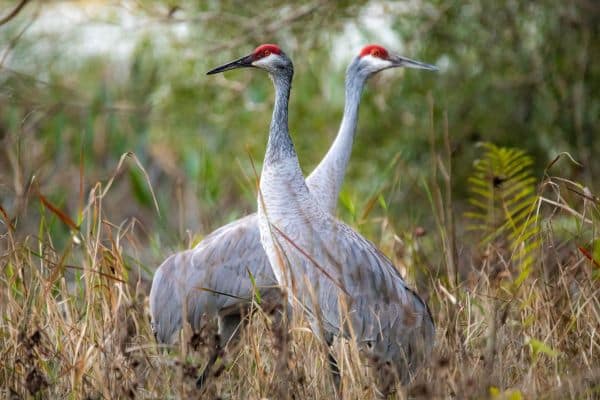
For visitors yearning to witness the grace of the Sandhill Crane, the Swan Lake-Heron Pond Loop, which covers around 3 miles, is an opportune trail. This pathway winds through a mix of wetlands and grasslands, habitats that cranes often choose for foraging and nesting.
The gentle terrain offers multiple vantage points to watch these birds, whether they are feeding, calling, or simply standing tall amidst the grasses.
While Sandhill Cranes exude an air of serenity, it’s essential to approach their observation with sensitivity. Disturbing them, especially during nesting, can have adverse effects.
It’s always best to watch quietly from a distance, using binoculars or a telephoto lens, ensuring these magnificent birds can thrive and continue to enrich the park’s biodiversity.
8 Best Hikes to See Wildlife in Grand Teton National Park
In the rugged wilderness of Grand Teton National Park, a network of trails invites hikers to explore diverse habitats, each promising a unique array of wildlife encounters.
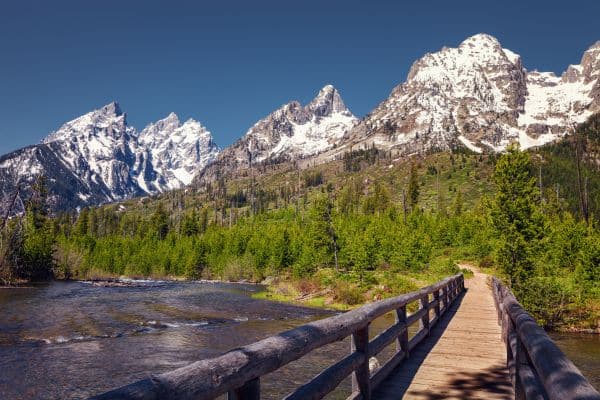
The majestic peaks and verdant valleys of the park teem with animals, and each trail offers a window into this vibrant world. Here’s a closer look at some standout hikes for wildlife enthusiasts:
Cascade Canyon Trail
Length: Approximately 9 miles round trip to the Forks.
Difficulty: Moderate.
Trail Description: The Cascade Canyon Trail begins with the option of a scenic boat ride across Jenny Lake, followed by a gentle climb into the heart of the Tetons. As hikers navigate through dense forests and open meadows, the chances of spotting mule deer, moose, and mountain bluebirds are high.
The burbling Cascade Creek accompanies much of the journey, and the deeper you venture, the more you increase your odds of perhaps encountering the elusive mountain lion or hearing the distant calls of pika echoing against granite walls.
Lakeshore Trail at Colter Bay
Length: Approximately 2 miles round trip.
Difficulty: Easy.
Trail Description: This serene loop around the shores of Jackson Lake is a wildlife lover’s dream. With the towering Tetons reflected in the water, hikers can frequently spot bald eagles and ospreys soaring overhead.
The edges of the lake provide prime real estate for beavers and North American river otters, with signs of their habitation often visible.
As the path meanders through stands of pines and past tranquil bays, there’s also the occasional opportunity to observe a foraging bear or grazing elk.
Teton Crest Trail
Length: About 40 miles, though many opt for shorter sections.
Difficulty: Strenuous.
Trail Description: The Teton Crest Trail is a journey through the alpine heart of Grand Teton. While it’s a challenging multi-day hike, the rewards are immense. From vast wildflower meadows to rugged mountain passes, this trail offers an ever-changing backdrop.
In the higher elevations, there’s the chance to see bighorn sheep deftly navigating rocky outcrops, or the white fluff of a mountain goat against a stark mountain backdrop.
The various alpine lakes along the route are also frequented by wildlife, making each campsite a potential theater of nature.
Garnet Canyon Trail
Length: Around 8.4 miles round trip.
Difficulty: Moderate to Strenuous.
Trail Description: A trail leading into the heart of the Teton Range, Garnet Canyon offers a mix of alpine terrain and dense forested areas. As you ascend, keep an eye out for moose in the marshy regions or pikas in the rocky areas.
The sounds of cascading water and the sight of diverse flora make this a visually stimulating hike. With a little luck, one might even spot a mountain lion or a red fox on the prowl.
Moose-Wilson Road
Length: 8 miles, though the road can also be driven.
Difficulty: Easy.
Trail Description: This winding, narrow road cuts through a varied landscape of dense forests and wetlands. Known for its frequent bear sightings, it’s also a haven for birdwatchers.
From the elusive call of the western tanager to the sight of a bald eagle perched high, this trail is a testament to Grand Teton’s avian diversity. The wetlands along the route are also frequented by moose, especially during dawn and dusk.
Death Canyon Trail
Length: Approximately 7.8 miles round trip to Phelps Lake overlook.
Difficulty: Moderate.
Trail Description: This aptly named trail leads hikers into a canyon offering breathtaking views and rich wildlife encounters. The alpine meadows here are frequented by bighorn sheep, while the forests echo with the calls of various bird species.
The trail’s higher elevation regions might reveal the white-tailed ptarmigan or even the traces of a wandering wolverine.
Amphitheater Lake Trail
Length: About 10 miles round trip.
Difficulty: Strenuous.
Trail Description: This trail, which climbs to one of the park’s most beautiful alpine lakes, is a challenging but rewarding hike. As you ascend, you traverse dense forests where black bears are often spotted.
The lake itself, set against the backdrop of the towering Tetons, is frequented by elk and mule deer, especially during the quieter hours of dawn and dusk.
Two Ocean Lake Trail
Length: 6.4 miles for the loop.
Difficulty: Moderate.
Trail Description: Skirting the edge of a serene lake, this trail offers ample opportunities for spotting wildlife. Otters can occasionally be seen playing in the water, while ospreys and eagles scan for fish from above. The surrounding grasslands are grazing sites for bison and pronghorns.
These trails provide diverse habitats and elevations, ensuring that hikers have a wide array of wildlife viewing opportunities in Grand Teton National Park. However, always ensure safety guidelines are followed to protect both the observer and the observed.
Wilderness Areas to See Animals in Grand Teton National Park
Grand Teton National Park, encompassing a vast area of approximately 310,000 acres, is a testament to the pristine wilderness of the American West. Though the entire park is managed with an emphasis on conservation, specific regions are designated as “wilderness areas.”
These areas are maintained in their natural state, with minimal human interference, to preserve the ecological and cultural resources inherent to the park.
Notable wilderness areas within Grand Teton include the Teton Wilderness, which shares its boundaries with neighboring Yellowstone, and the Gros Ventre Wilderness to the southeast of the park.
Teton Wilderness
Located in the northeast of Grand Teton National Park, bordering Yellowstone National Park, Teton Wilderness is a vast, pristine region spanning over 585,000 acres.
This remote wilderness is a haven for elk during their seasonal migrations. With rugged terrains, dense forests, and sparkling streams, the area is a mosaic of nature’s wonders.
Numerous trails, like the Continental Divide Trail, traverse this wilderness, offering adventurers a taste of untamed beauty.
It’s not uncommon to find moose wading in the area’s numerous streams or to hear the haunting howl of wolves echoing in the distance. Teton Wilderness stands as a testament to the wild, untouched spirit of the American West.
Gros Ventre Wilderness
In the southeast of Grand Teton National Park, the Gros Ventre Wilderness encompasses over 317,000 acres. It is characterized by its varied landscapes—from alpine meadows bursting with wildflowers to craggy mountain peaks.
The Gros Ventre River, with its clear waters, snakes through the wilderness, creating a lifeline for numerous species. This area is notably home to the native cutthroat trout, and its dense woods often echo with the bugling of elk, especially during the rutting season.
With fewer visitors than other areas, the Gros Ventre Wilderness offers solitude and a deep connection to nature.
Jedediah Smith Wilderness
Location: West of Grand Teton National Park, bordering Idaho.
Named after the famous explorer Jedediah Smith, this wilderness area covers over 123,000 acres, characterized by its unique karst limestone formations. The area boasts over 175 miles of trails, winding through dense forests, open meadows, and past alpine lakes.
It’s particularly known for its rich variety of bird species, making it a paradise for birdwatchers. The Teton Range’s western slope here is gentler, covered with dense coniferous forests that are home to black bears, mountain lions, and a myriad of smaller mammals.
The wilderness’s western boundary is a favorite among rock climbers, with the Teton Range offering challenging ascents.
Death Canyon
Located on the western face of the Teton Range, Death Canyon provides a captivating mix of dense forests, steep cliffs, and alpine lakes. As one treks the Death Canyon Trail, the likelihood of spotting mule deer, pikas, and even the occasional black bear is high.
The upper reaches, particularly around Static Peak Divide, offer breathtaking panoramas and might reveal sightings of bighorn sheep or golden eagles.
Leigh Lake
A serene spot on the eastern edge of the Tetons, the Leigh Lake area is a haven for waterfowl and aquatic life. Hikers around Leigh Lake and String Lake can frequently spot bald eagles, ospreys, and otters.
The dense woods surrounding the lake often harbor moose, especially during the early morning and twilight hours.
Paintbrush Canyon
This challenging hike brings adventurers face-to-face with the rugged beauty of the Tetons. As the trail winds upwards through subalpine forests, sightings of pine martens, red foxes, and Clark’s nutcrackers become more common.
The higher elevations, especially around Holly Lake, are often visited by mountain goats and peregrine falcons.
Antelope Flats
A vast expanse of grasslands and sagebrush, Antelope Flats is iconic for its historic barns set against the Teton backdrop. But the real stars here are the wildlife.
Large herds of bison are commonly seen grazing in the area, and it’s one of the best places to see pronghorns. As dusk approaches, the haunting calls of coyotes often pierce the stillness.
Snake River Overlook
With the majestic winding river framed by the Tetons, this location is more than just a photographer’s dream.
The riparian habitats along the Snake River are frequented by beavers, moose, and a wide variety of bird species, including trumpeter swans and sandhill cranes.
Wildlife Viewing Tips in Grand Teton National Park
Grand Teton National Park offers some of the most remarkable wildlife viewing opportunities in the U.S. For visitors seeking to maximize their experience while ensuring the safety of both themselves and the park’s inhabitants, here are some unique and relevant wildlife viewing tips tailored to this majestic locale:
- Best Times of Day: Many of Grand Teton’s creatures, like moose, elk, and bears, are crepuscular, meaning they’re most active during dawn and dusk. Plan your outings around these times to increase your chances of encounters.
- Safe Distances: Always maintain a safe distance from all wildlife. The park recommends at least 100 yards from bears and wolves and 25 yards from other animals, including nesting birds.
- Use Optics: A pair of binoculars or a spotting scope can enhance your viewing experience. This allows you to observe animals closely without getting too near, minimizing disturbance.
- Stay Quiet and Still: Loud noises or sudden movements can stress wildlife and alter their natural behaviors. Speak in hushed tones and avoid sudden movements.
- Drive Cautiously: Especially during dawn and dusk, animals frequently cross park roads. Always adhere to speed limits and be vigilant. If you spot wildlife while driving, pull over only in designated areas without obstructing traffic.
- Learn Animal Behavior: Recognizing signs of distress in animals can prevent dangerous encounters. For example, a bear clacking its teeth, huffing, or stomping the ground is signaling that you’re too close.
- Travel in Groups: When hiking in bear country, traveling in groups can deter unwanted encounters. Making noise, whether through talking or carrying bear bells, can also alert bears to your presence.
- Store Food Properly: Always store food, toiletries, and garbage in bear-proof containers or storage areas. This not only protects you but also prevents animals from becoming conditioned to human food.
- Attend Ranger-led Programs: Rangers often lead wildlife viewing programs and can offer insights into where and when to see specific animals. They also provide safety guidelines tailored to the day’s conditions.
- Seasonal Awareness: Different seasons offer varied viewing opportunities. For instance, spring brings migrating birds and bears emerging from hibernation, while fall features elk rutting season.
- Tread Lightly: Stick to designated trails to minimize habitat disturbance. Off-trail hiking can inadvertently lead to habitat destruction or the displacement of wildlife.
- Stay Informed: Before heading out, check for any park alerts or closures. Areas may be closed temporarily due to animal activity, especially during mating, nesting, or when young are present.
By following these tips, visitors can ensure a memorable, respectful, and safe wildlife viewing experience in Grand Teton National Park. The magic of the park lies in its unspoiled wilderness, and with mindful observation, one can witness the intricate dance of nature unfolding.
Conclusion
In the shadow of the majestic peaks of Grand Teton National Park lies a world brimming with wildlife, each species weaving its tale in the grand narrative of nature. From the elusive mountain lion to the iconic bison, the park offers an unparalleled opportunity for visitors to witness North America’s wildlife in all its glory.
Through the recommended trails and designated wilderness areas, we gain not just a physical journey, but also an insight into the lives of these animals, understanding their habitats, behaviors, and roles in the ecosystem. As we venture into this wild realm, it’s essential to tread with respect, understanding, and a sense of responsibility.
For in preserving the sanctity of these spaces and the creatures that call them home, we ensure that future generations too can experience the awe, wonder, and privilege of sharing a moment with the wild inhabitants of Grand Teton National Park.


